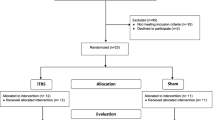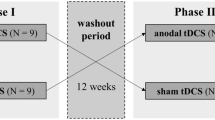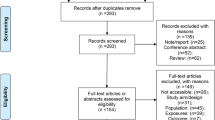Abstract
Exercise therapy (ET) can be beneficial in disabled multiple sclerosis (MS) patients. Intermittent transcranial magnetic theta burst stimulation (iTBS) induces long-term excitability changes of the cerebral cortex and may ameliorate spasticity in MS. We investigated whether the combination of iTBS and a program of ET can improve motor disability in MS patients. In a double-blind, sham-controlled trial, 30 participants were randomized to three different interventions: iTBS plus ET, sham stimulation plus ET, and iTBS alone. Before and after 2 weeks of treatment, measures of spasticity through the modified Ashworth scale (MAS) and the 88 items Multiple Sclerosis Spasticity Score questionnaire (MSSS-88), fatigue through the Fatigue Severity Scale (FSS), daily living activities (ADL) through the Barthel index and health-related quality of life (HRQoL) through the 54 items Multiple Sclerosis Quality of life inventory (MSQoL-54) were collected. iTBS plus ET reduced MAS, MSSS-88, FSS scores, while in the Barthel index and MSQoL-54, physical composite scores were increased. iTBS alone caused a reduction of the MAS score, while none of the measured scales showed significant changes after sham iTBS plus ET. iTBS associated with ET is a promising tool for motor rehabilitation of MS patients.



Similar content being viewed by others
References
Compston A, Coles A (2008) Multiple sclerosis. Lancet 372:1502–1517
Langdon DW, Thompson AJ (1999) Multiple sclerosis: a preliminary study of selected variables affecting rehabilitation outcome. Mult Scler 5:94–100
Mostert S, Kesselring J (2002) Effects of a short-term exercise training program on aerobic fitness, fatigue, health perception and activity level of subjects with multiple sclerosis. Mult Scler 8:161–168
Rietberg MB, Brooks D, Uitdehaag BM, Kwakkel G (2005) Exercise therapy for multiple sclerosis. Cochrane Database Syst Rev CD003980
Motl RW, McAuley E (2009) Longitudinal analysis of physical activity and symptoms as predictors of change in functional limitations and disability in multiple sclerosis. Rehabil Psychol 54:204–210
Tyč F, Boyadjian A (2011) Plasticity of motor cortex induced by coordination and training. Clin Neurophysiol 122:153–162
Ziemann U, Iliac TV, Pauli C, Meintzschel F, Ruge D (2004) Learning modifies subsequent induction of long-term potentiation-like and long-term depression-like plasticity in human motor cortex. J Neurosci 24:1666–1672
Hummel FC, Cohen LG (2006) Non-invasive brain stimulation: a new strategy to improve neurorehabilitation after stroke? Lancet Neurol 5:708–712
Nielsen JF, Sinkjaer T, Jakobsen J (1996) Treatment of spasticity with repetitive magnetic stimulation; a double-blind placebo-controlled study. Mult Scler 2:227–232
Mori F, Codecà C, Kusayanagi H, Monteleone F, Boffa L, Rimano A et al (2010) Effects of intermittent theta burst stimulation on spasticity in patients with multiple sclerosis. Eur J Neurol 17:295–300
Centonze D, Koch G, Versace V, Mori F, Rossi S, Brusa L et al (2007) Repetitive transcranial magnetic stimulation of the motor cortex ameliorates spasticity in multiple sclerosis. Neurology 68:1045–1050
Barnes MP, Kent RM, Semlyen JK, McMullen KM (2007) Spasticity in multiple sclerosis. Neurorehabil Neural Repair 17:66–70
McDonald WI, Compston A, Edan G, Goodkin D, Hartung HP, Lublin FP et al (2001) Recommended diagnostic criteria for multiple sclerosis: guidelines from the international panel on the diagnosis of multiple sclerosis. Ann Neurol 50:121–127
Ghotbi N, Ansari NN, Naghdi S, Hasson S, Jamshidpour B, Amiri S (2009) Inter-rater reliability of the Modified Ashworth Scale in assessing lower limb muscle spasticity. Brain Inj 23:815–819
Hobart JC, Riazi A, Thompson AJ, Styles IM, Ingram W, Vickery JP et al (2006) Getting the measure of spasticity in multiple sclerosis: the Multiple Sclerosis Spasticity Scale (MSSS-88). Brain 129:224–234
Krupp LB, La Rocca NG, Muir-Nash J et al (1989) The fatigue severity scale. Application to patients with multiple sclerosis and systemic lupus erythematosus. Arch Neurol 46:1121–1123
Van der Putten JJ, Hobart JC, Freeman JA, Thompson AJ (1999) Measuring change in disability after inpatient rehabilitation: comparison of the responsiveness of the Barthel index and the Functional Independence Measure. J Neurol Neurosurg Psychiatry 66:480–484
Kurtzke JF (1983) Rating neurologic impairment in multiple sclerosis: an expanded disability status scale (EDSS). Neurology 33:1444–1452
Solari A, Filippini G, Mendozzi L et al (1999) Validation of Italian multiple sclerosis quality of life 54 questionnaire. J Neurol Neurosurg Psychiatry 67:158–162
Stuifbergen AK, Blozis SA, Harrison TC, Becker HA (2006) Exercise, functional limitations, and quality of life: a longitudinal study of persons with multiple sclerosis. Arch Phys Med Rehabil 87:935–943
Peterson C (2001) Exercise in 94 degrees F water for a patient with multiple sclerosis. Phys Ther 81:1049–1058
Gehlsen GM, Grigsby SA, Winant DM (1984) Effects of an aquatic fitness program on the muscular strength and endurance of patients with multiple sclerosis. Phys Ther 64:653–657
Guthrie TC, Nelson DA (1995) Influence of temperature changes on multiple sclerosis: critical review of mechanisms and research potential. J Neurol Sci 129:1–8
Kesiktas N, Paker N, Erdogan N, Gulsen G, Bicki D, Yilmaz H (2004) The use of hydrotherapy for the management of spasticity. Neurorehabil Neural Repair 18:268–273
White LJ, Dressendorfer RH (2004) Exercise and multiple sclerosis. Sports Med 34:1077–1100
Asano M, Dawes DJ, Arafah A, Moriello C, Mayo NE (2009) What does a structured review of the effectiveness of exercise interventions for persons with multiple sclerosis tell us about the challenges of designing trials? Mult Scler 15:412–421
Cooke SF, Bliss TV (2006) Plasticity in the human central nervous system. Brain 129:1659–1673
Bliss TV, Lømo T (1973) Long-lasting potentiation of synaptic transmission in the dentate area of the anaesthetized rabbit following stimulation of the perforant path. J Physiol 232:331–356
Sala C, Piëch V, Wilson NR, Passafaro M, Liu G, Sheng M (2001) Regulation of dendritic spine morphology and synaptic function by Shank and Homer. Neuron 31:115–130
Tyc F, Boyadjian A, Devanne H (2005) Motor cortex plasticity induced by extensive training revealed by transcranial magnetic stimulation in human. Eur J Neurosci 21:259–266
Clark BC, Issac LC, Lane JL, Damron LA, Hoffman RL (2008) Neuromuscular plasticity during and following 3 wk of human forearm cast immobilization. J Appl Physiol 105:868–878
Holtmaat A, Svoboda K (2009) Experience-dependent structural synaptic plasticity in the mammalian brain. Nat Rev Neurosci 10:647–658
Stagg CJ, Wylezinska M, Matthews PM, Johansen-Berg H, Jezzard P, Rothwell JC et al (2009) Neurochemical effects of theta burst stimulation as assessed by magnetic resonance spectroscopy. J Neurophysiol 101:2872–2877
Michael N, Gosling M, Reutemann M, Kersting A, Heindel W, Arolt V et al (2003) Metabolic changes after repetitive transcranial magnetic stimulation (rTMS) of the left prefrontal cortex: a sham-controlled proton magnetic resonance spectroscopy (1H MRS) study of healthy brain. Eur J Neurosci 17:2462–2468
Strafella AP, Paus T, Fraraccio M, Dagher A (2003) Striatal dopamine release induced by repetitive transcranial magnetic stimulation of the human motor cortex. Brain 126:2609–2615
Butefisch CM, Davis BC, Wise SP, Sawaki L, Kopylev L, Classen J et al (2000) Mechanisms of use-dependent plasticity in the human motor cortex. Proc Natl Acad Sci USA 97:3661–3665
Ydin-Abidin S, Trippe J, Funke K, Eysel UT, Benali A (2008) High- and low-frequency repetitive transcranial magnetic stimulation differentially activates c-Fos and zif268 protein expression in the rat brain. Exp Brain Res 188:249–261
Zhang X, Mei Y, Liu C, Yu S (2007) Effect of transcranial magnetic stimulation on the expression of c-Fos and brain-derived neurotrophic factor of the cerebral cortex in rats with cerebral infarct. J Huazhong Univ Sci Technol Med Sci 27:415–418
Patterson SL, Abel T, Deuel TA, Martin KC, Rose JC, Kandel ER (1996) Recombinant BDNF rescues deficits in basal synaptic transmission and hippocampal LTP in BDNF knockout mice. Neuron 16:1137–1145
Guzowski JF (2002) Insights into immediate-early gene function in hippocampal memory consolidation using antisense oligonucleotide and fluorescent imaging approaches. Hippocampus 12:86–104
Müller JF, Orekhov Y, Liu Y, Ziemann U (2007) Homeostatic plasticity in human motor cortex demonstrated by two consecutive sessions of paired associative stimulation. Eur J Neurosci 25:3461–3468
Huang YZ, Rothwell JC, Edwards MJ, Chen RS (2008) Effect of physiological activity on an NMDA-dependent form of cortical plasticity in human. Cereb Cortex 18:563–570
Acknowledgments
We thank Dr. Alessandro Moscatelli for helpful statistical advice. This investigation was supported by Fondazione Italiana Sclerosi Multipla (Progetto Speciale 2010) to DC.
Conflict of interest
The authors have no financial interests or conflicts of interest to disclose.
Author information
Authors and Affiliations
Corresponding author
Additional information
C. Foti and D. Centonze equally contributed to the present work.
Rights and permissions
About this article
Cite this article
Mori, F., Ljoka, C., Magni, E. et al. Transcranial magnetic stimulation primes the effects of exercise therapy in multiple sclerosis. J Neurol 258, 1281–1287 (2011). https://doi.org/10.1007/s00415-011-5924-1
Received:
Revised:
Accepted:
Published:
Issue Date:
DOI: https://doi.org/10.1007/s00415-011-5924-1




